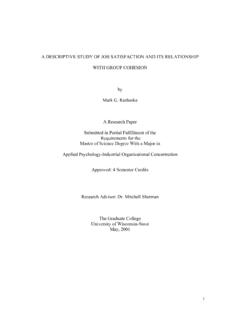Transcription of SUGI 28: Survival Analysis Using Cox Proportional Hazards ...
1 Survival Analysis Using Cox Proportional Hazards Modeling For Single And Multiple Event Time Data Tyler Smith, MS; Besa Smith, MPH; and Margaret AK Ryan, MD, MPH Department of Defense Center for Deployment Health Research, Naval Health Research Center, San Diego, CA Abstract Survival Analysis techniques are often used in clinical and epidemiologic research to model time until event data. Using SAS system's PROC PHREG, Cox regression can be employed to model time until event while simultaneously adjusting for influential covariates and accounting for problems such as attrition, delayed entry, and temporal biases.
2 Furthermore, by extending the techniques for single event modeling, the researcher can model time until multiple events. In this real data example, PROC PHREG with the baseline option was instrumental in handling attrition of subjects over a long study period and producing probability of hospitalization curves as a function of time. In this paper, the reader will gain insight into Survival Analysis techniques used to model time until single and multiple hospitalizations Using PROC PHREG and tools available through SAS Introduction Survival Analysis pertains to a statistical approach designed to take into account the amount of time an experimental unit contributes to a study period, or the study of time between entry into observation and a subsequent event.
3 Originally, the event of interest was death and the Analysis consisted of following the subject until death. The use of Survival Analysis today is primarily in the medical and biological sciences, however these techniques are also widely used in the social sciences, econometrics, and engineering. Events or outcomes are defined by a transition from one discrete state to another at an instantaneous moment in time. Examples include time until onset of disease, time until stockmarket crash, time until equipment failure, and so on.
4 Although the origin of Survival Analysis goes back to mortality tables from centuries ago, this type of Analysis was not well developed until World War II. A new era of Survival Analysis emerged that was stimulated by interest in reliability (or failure time) of military equipment. At the end of the war, the use of these newly developed statistical methods quickly spread through private industry as customers became more demanding of safer, more reliable products. As the use of Survival Analysis grew, researchers began to develop nonparametric and semiparametric approaches to fill in gaps left by parametric methods.
5 These methods became popular over other parametric methods due to the relatively robust model and the ability of the researcher to be blind to the exact underlying distribution of Survival times. Survival Analysis has become a popular tool used in clinical trials where it is well suited for work dealing with incomplete data. Medical intervention follow-up studies are plagued with late arrivals and early departure of subjects. Survival Analysis techniques allow for a study to start without all experimental units enrolled and to end before all experimental units have experienced an event.
6 This is extremely important because even in the most well developed studies, there will be subjects who choose to quit participating, who move too far away to follow, who will die from some unrelated event, or will simply not have an event before the end of the observation period. The researcher is no longer forced to withdraw the experimental unit and all associated data from the study. Instead, censoring techniques enable researchers to analyze incomplete data due to delayed entry or withdrawal from the study.
7 This is important in allowing each experimental unit to contribute all of the information possible to the model for the amount of time the researcher is able to observe the unit. The recent strides in the application of Survival Analysis techniques have been a direct result of the availability of software packages and high performance computers which are now able to run the difficult and computationally intensive algorithms used in these types of analyses relatively quickly and efficiently. Basic Tools of Survival Analysis First recall that time is continuous, and that the probability of an event at a single point of a continuous distribution is zero.
8 Our first challenge is to define the probability of these events over a distribution. This is best described by graphing the distribution of event times. To ensure the SUGI 28 Statistics and Data Analysis reader will start with the same fundamental tools of Survival Analysis , a brief descriptive section of these important concepts will follow. A more detailed description of the probability density function (pdf), the cumulative distribution function (cdf), the hazard function, and the Survival function, can be found in any intermediate level statistical textbook.
9 So that the reader will be able to look for certain relationships, it is important to note the one-to-one relationship that these four functions possess. The pdf can be obtained by taking the derivative of the cdf and likewise, the cdf can be obtained by taking the integral of the pdf. The Survival function is simply 1 minus the cdf, and the hazard function is simply the pdf divided by the Survival function. It will be these relationships later that will allow us to calculate the cdf from the Survival function estimates that the SAS procedure PROC PHREG will output.
10 The Cumulative Distribution Function The cumulative distribution function is very useful in describing the continuous probability distribution of a random variable, such as time, in Survival Analysis . The cdf of a random variable T, denoted FT (t), is defined by FT (t) = PT (T < t). This is interpreted as a function that will give the probability that the variable T will be less than or equal to any value t that we choose. Several properties of a distribution function F(t) can be listed as a consequence of the knowledge of probabilities.











